'Hybrid' Die Design Eliminates Weld Lines, Cuts Stagnation
NPE2024: Newest extrusion tool retains benefits of previous design and adds features to boost quality.
The 800 Series Hybrid is Guill Tool’s newest version of its 800 series. In some extrusion applications that utilize crossheads and inlines, layers of the exact same material are applied multiple times, using a single die. This method is used to reduce the propensity for errors caused by gels breaking through a thin wall, weld lines, inconsistent wall thickness, plus material and process variations. Additional errors include difficult-to-process materials and demanding applications where there is zero fault tolerance.
Seeking to design the next-generation multilayer die to overcome these challenges, the engineers at Guill looked for a way to incorporate this technology into an updated version of the 800 Series. This led to the creation of the 800 Series Hybrid.
The new design retains the inherent benefits of the 800 Series, including compact design, low residence time and a common deflector bore that eliminates tolerance stack-up. The challenge was to create a hybrid design that incorporates the benefits of layer overlapping while reducing unnecessary complexity and making the technology more cost-affordable for customers. This was achieved by overlapping layers in each semideflector, using a single cone. The highly efficient design of the 800 Series Hybrid reduces cost and size, as opposed to other methods of overlapping layers.

Source: Guill Tool
Critical benefits of the 800 Series Hybrid include eliminating weld lines in materials through patented overlapping technology, producing a more consistent finished product; reduced sensitivity to changes in viscosity; reduced sensitivity to changes in line speed; myriad material and multilayer application possibilities; works in all tubing and jacketing applications with a wide range of materials; low residence time; compact design and a low tolerance stack-up error factor, all resulting in improved concentricity.
The 800 Series Hybrid extrusion tool greatly reduces stagnation, because overlapping layers are more inherently balanced than single layers and also because each semideflector is “tuned to flush.” Conventional deflectors must simultaneously achieve a balance between flushing, balancing and eliminating the weld line. There is less difference between the slowest moving material and the fastest moving material in the deflector channels, thus making the viscosity more consistent in the deflector.
Related Content
-
Extrusion Veteran Scuralli Starts Sales Rep Firm
Former owner of Wayne Machine & Die to represent suppliers of extrusion systems and components.
-
Bonding, Sintering Tech Advances Metal Bonding for Mold, Die Components
NPE2024: Punch Industry USA exhibits P-Bas, intended to replace the use of 3D printers when producing mold and die components, as well as a variety of mold component supplies.
-
New Rotary Die and Cam Lock Design for Tubing
NPE2024: New design enables quick and easy assembly and disassembly of the crosshead, and eliminates the socket head cap screws.






